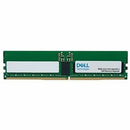Description
Upgrade your Dell ecosystem with a purpose-built memory module that blends performance, reliability, and seamless compatibility. This 32 GB DDR5 RAM module is designed for Dell servers and workstations that demand high-speed memory to keep up with modern workloads. With a speed of 5600 MT/s, this memory expands capacity while delivering the bandwidth needed for virtualization, large-scale databases, memory-intensive computing, and multitasking without bottlenecks. The 2Rx8 RDIMM structure provides improved data integrity and channel interleaving, enabling more efficient access patterns across memory channels and helping your system handle heavy workloads with fewer stalls. Dell-branded and thoroughly QA-tested, this memory option is part of Dell’s Memory Selector ecosystem, giving you confidence that the module has met Dell’s stringent compatibility and reliability standards for supported platforms. Important compatibility note: this module is not compatible with 4800 MT/s DIMMs, so you should verify your system’s supported speed and memory type before upgrading.
- Maximize performance for Dell servers and workstations with a single, high-density 32 GB module that expands memory capacity for demanding tasks such as virtualization, data analytics, and large-scale simulations, ensuring smoother multitasking and faster data access.
- Experience the power of DDR5 technology, which delivers higher bandwidth and improved efficiency compared to previous generations. At 5600 MT/s, this module helps reduce memory bottlenecks and supports faster data transfer rates for memory-hungry applications and modern workloads.
- Choose 2Rx8 RDIMM for robust reliability and better channel interleaving. The registered DIMM design helps stabilize performance under heavy load and across multiple memory banks, making it a reliable choice for Dell servers that require consistent memory access patterns.
- Rely on Dell-branded memory that has undergone rigorous quality assurance and compatibility testing within Dell’s Memory Selector ecosystem. This ensures a higher likelihood of seamless integration, aligned with Dell hardware, firmware, and software ecosystems for enterprise deployments.
- Note the critical compatibility constraint: this 32 GB DDR5 RDIMM is not compatible with 4800 MT/s DIMMs. Before upgrading, confirm that your Dell system supports 5600 MT/s RDIMM modules and that you are selecting the proper memory type (DDR5 RDIMM) and speed for your motherboard or server configuration.
Technical Details of Dell Memory Upgrade - 32 GB - 2Rx8 DDR5 RDIMM 5600MT/s
- Capacity: 32 GB per module
- Memory Type: DDR5 Registered DIMM (RDIMM)
- Speed: 5600 MT/s
- Rank: 2Rx8
- Form Factor: DIMM
- Compatibility Note: Not compatible with 4800 MT/s DIMMs; designed for systems that support DDR5 RDIMM at 5600 MT/s
- Branding and QA: Dell-branded memory subjected to extensive compatibility testing within Dell’s Memory Selector program
How to install Dell Memory Upgrade
- Power down the system completely and unplug all power sources. If you’re working on a server, ensure it is safely shut down and that you follow your data-center procedures for maintenance to prevent accidental power on during installation.
- Ground yourself to discharge any static electricity. Use an anti-static wrist strap or regularly touch a grounded metal surface to avoid damaging sensitive components.
- Open the computer or server chassis to access the memory slots. Locate the memory bank area on the motherboard and identify available DIMM slots or existing modules for reference on placement and configuration.
- Hold the DDR5 RDIMM by its edges, avoiding touching the gold connectors. Align the notch on the module with the key in the slot, ensuring the module is oriented correctly before seating.
- Insert the module into the slot with steady, even pressure until it is fully seated and the locking latches engage on both sides. A firm click on each side indicates proper seating.
- If upgrading with multiple modules, repeat the process for each stick, ensuring balanced placement across memory channels to maximize interleaving and performance. Consult your system manual for the recommended slot order for best results.
- Replace the chassis cover, reconnect power, and boot the system. Enter the BIOS/UEFI to verify that the new memory is recognized at the correct speed and size. If necessary, enable XMP or equivalent settings for DDR5, or set the speed manually to 5600 MT/s according to the motherboard’s guidance.
- Run a memory diagnostics test or a lightweight benchmark to confirm stability under load and verify that the system correctly reports the total installed memory without errors.
Frequently asked questions
- Q: What is the capacity and speed of this memory module? A: The module is 32 GB, DDR5 RDIMM, rated at 5600 MT/s, designed for Dell systems that support this specification. It is intended to be used in Dell servers and workstations that require high-speed memory and large capacity.
- Q: Is this module compatible with 4800 MT/s DIMMs? A: No. This module is specifically designed for 5600 MT/s operation and is not compatible with 4800 MT/s DIMMs. Verify your system’s supported speed and memory type before upgrading.
- Q: What type of system should I use this memory in? A: It is intended for Dell servers and workstations that support DDR5 RDIMM at 5600 MT/s. Check your motherboard or server manual, Dell Memory Selector, or Dell support resources to confirm compatibility.
- Q: Do I need to replace all memory to gain full benefit? A: Not necessarily, but performance gains are often maximized when upgrading in matched configurations (same capacity, speed, and rank) across memory channels. Always aim for balanced configurations per vendor recommendations.
- Q: How can I verify installation success? A: After installation, boot the system and check BIOS/UEFI memory reports to confirm the module is detected at 5600 MT/s. You can also run a memory diagnostic tool or a brief stress test to ensure stability and error-free operation.
Customer reviews
Showing - Of Reviews


